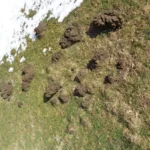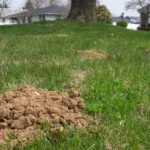Have you ever wondered why your perfectly manicured lawn suddenly has mounds of dirt on it? You may have a mole problem. Moles are small, subterranean mammals that are notorious for their tunneling and digging habits. Their activity not only damages lawns and gardens but can also disrupt soil structure and promote weed growth. Understanding the migration patterns of moles is crucial in implementing effective control measures. In this article, we will explore the various reasons why moles migrate, their migration habits, and how to identify their patterns. Additionally, we will provide you with tips on how to control mole populations to protect your property.
Moles Migration: What You Need to Know

Understanding the behavior of moles is important for preventing them from causing damage to your yard or garden. Moles are highly active creatures, and they are known to migrate for a variety of reasons. In this section, we will explore everything you need to know about moles migration, including why moles migrate, when they migrate, where they migrate, and how they migrate. Additionally, we will discuss identifying mole migration patterns, and effective mole control methods. By understanding moles’ migration patterns, you can take the necessary steps to prevent them from damaging your property.
Why Do Moles Migrate?
One of the questions surrounding mole migration is why do moles migrate? Several factors contribute to moles’ decision to move from one location to another, including food availability, soil quality, and population density. In some cases, moles migrate due to environmental changes caused by natural disasters like flooding or wildfires.
Moles require a diet rich in invertebrates such as earthworms and grubs. When food sources become scarce in their current location, moles may move to a new area where they can find more food. Similarly, soil quality plays a significant role in moles’ migration patterns. Moles prefer loose, moist soil that allows them to tunnel and hunt more effectively. If the soil in their current location becomes too dry or compacted, they may move elsewhere in search of better soil quality.
Population density is another factor that can drive mole migration. If there are too many moles in a particular area, competition for food and territory can become intense, leading some moles to migrate to a new location with fewer competitors.
Understanding the reasons behind mole migration can help homeowners better control these pests. By maintaining healthy soil conditions and taking steps to prevent overpopulation, homeowners can reduce the likelihood of moles migrating into their yards. Check out our article on preventing moles from migrating in your yard for more information on mole prevention.
When Do Moles Migrate?
Moles have a unique migration pattern, and understanding when they migrate is crucial for effective control.
The timing of moles’ migration mainly depends on the seasons and soil conditions. The following can be considered the prime migration season for moles:
- Spring: During spring, moles start to migrate from their winter shelters in search of new feeding grounds. The soil remains moist, making it easier for them to dig tunnels.
- Summer: In hot summer weather, the soil becomes dry and hard, making it difficult for moles to dig. They mostly migrate to nearby soil with more moisture content, which aids their burrowing activity.
- Fall: During fall, the soil moisture levels rise again, and insects become active due to higher humidity. Moles migrate during this season to take advantage of the increased availability of their favorite foods.
- Winter: In winter, moles migrate to deeper soils below the frost line to avoid harsh weather conditions. The tunnels they dig in winter stay consistent, and they have separate nests for warmth.
Knowing the migration patterns of moles is helpful in identifying when they are most active and when to put preventive measures in place. Understanding the soil types that moles prefer and the geological structures under the soil can provide an insight into the timing of their migrations. To learn more about the relation between moles and soil types, read our article “Soil Type and Moles Migration – What You Need to Know“.
Where Do Moles Migrate?
Moles are known to migrate in search of food, mates, and shelter. They are active burrowers and move around underground in a complicated system of tunnels. Where they migrate depends on various factors such as the availability of soil moisture, the abundance of insects and worms, and the availability of habitats for nesting and wintering. According to studies, moles tend to show a preference for soils that are moist, well-drained, and rich in organic matter.
Moles are commonly found in gardens and lawns where they can cause extensive damage by building unsightly molehills and tunnels. They can also damage underground cables and irrigation systems. These creatures are known for their ability to dig tunnels at a rapid pace, and their migration patterns can be unpredictable.
Moles are found across the world in a variety of habitats, including grasslands, woodlands, and urban areas. According to moles navigation migration science, they can travel up to 100 yards per day and follow their prey, particularly earthworms. They can also migrate to higher ground during periods of heavy rainfall, or when the soil becomes waterlogged.
The table below summarizes the places where moles may migrate to:
| Location | Reasons for Migration |
|---|---|
| Gardens and Lawns | Availability of soil moisture, abundance of insects and worms, nesting and wintering sites |
| Fields and Pastures | Rich in organic matter, availability of food and mates |
| Woodlands | Abundance of earthworms, insects and organic matter |
| Urban Areas | Availability of suitable environments for burrowing, food and mates |
It is important to understand benefits and drawbacks of moles migration so as to be able to control and reduce the damage caused by these creatures. In order to prevent moles from migrating to an area, gardeners and homeowners should ensure that the soil is not too moist, that there are not too many earthworms and insects, and that there are no nesting sites for moles. Additionally, it is important to remove any debris that could provide shelter or hiding places for moles.
By understanding the moles migration season guide, gardeners can plan their planting and lawn maintenance activities to minimize damage caused by moles. They can also learn how to track moles migration in their gardens and identify the signs of their presence. They can learn about natural and chemical moles control methods and do-it-yourself moles control methods or hiring professional moles control services to effectively control these creatures.
How Do Moles Migrate?
Moles migrate to search for food and to reproduce. They can cover a distance of up to 5 meters per minute. They dig deep tunnels, which could be as deep as 2 feet, in search of insects and worms which constitute their diet. They also migrate when they are forced to leave their current location due to changes in the soil’s texture and moisture content.
Moles generate a lot of energy when moving through the soil, and this energy needs to be replenished through the consumption of food. They must move into new areas with high insect populations to fuel their daily energy needs. Moles also migrate to find prospective mates and to avoid getting into fights with other moles over territory.
The table below shows the factors that affect mole migration:
| Factors that Affect Mole Migration | Explanation |
|---|---|
| Food Availability | If there aren’t enough insects and worms in their current location, moles will migrate to find areas with a higher population of prey. |
| Soil Characteristics | Moles prefer soil that is loose, humid, and easy to dig through, so changes in soil composition or moisture levels can cause them to migrate. |
| Temperature | Moles will migrate to areas with temperate climates to seek shelter from extreme heat or cold during different seasons. |
| Mating Season | Male moles migrate to find female mates, and vice versa. This usually occurs in spring and summer. |
| Competition | If two or more moles are living in the same location, they will typically fight over territory, prompting one or both of them to migrate to a new area. |
Understanding how moles migrate and the factors that influence their migration is crucial in controlling their presence in gardens and lawns. By understanding their behavior, we can take preventative measures to stop moles from migrating to specific locations, such as using mole repellents or creating barriers around gardens. For more information on how to stop moles from migrating to your garden, read our article on how to stop mole migration.
Identifying Moles Migration Patterns

One of the key factors in effective mole control is understanding their migration patterns. Identifying these patterns helps in tracking the movement of moles and preventing them from causing damage to lawns and gardens. By understanding where and when moles migrate, one can take appropriate action to control the population. This section delves into the importance of identifying moles migration patterns and provides information on how to track their movement. Understanding the difference between moles migration and hibernation is also essential in understanding their behavior.
The Importance of Identifying Moles Migration Patterns
Identifying Moles Migration Patterns is crucial for effective mole control. By knowing their migration patterns, it becomes easier to detect the presence of moles in an area, assess the extent of mole infestation, and apply the most appropriate control methods. Here are some reasons why identifying mole migration patterns is important:
| Importance of Identifying Moles Migration Patterns |
|---|
| Early Detection: By identifying and tracking the movement of moles, it becomes possible to detect their presence early on. This can help prevent damage to lawns and gardens caused by mole activities. |
| Effective Control: Identifying mole migration patterns can help in applying the most effective control methods. This is because certain control methods work better during specific times of the year. |
| Prevent Damage: By understanding where moles are likely to migrate, property owners can take preventative measures to discourage moles from entering their lawn or garden area. This can save time and money by preventing damage to plants and gardens. |
| Save Money: By detecting the presence of moles early on and identifying their migration patterns, property owners can avoid the need for expensive repairs from mole damage. |
Identifying moles migration patterns can help with early detection, effective control, preventing damage, and ultimately saving money. It is an essential part of mole management that should not be overlooked. Homeowners should keep an eye on signs of mole migration and take action accordingly. To learn more about how to keep moles away from the garden, check out our comprehensive guide.
Signs of Moles Migration
One of the most important steps in understanding and controlling moles is to identify the signs of their migration. These signs can vary, but generally include changes in the mole’s behavior, as well as physical signs in your yard. Here are some common signs that moles may be on the move:
| Signs of Moles Migration |
|---|
| Increased Activity: One of the most obvious signs of mole migration is an increase in activity. These animals are constantly digging and searching for food, but when they’re on the move, you may notice even more digging and tunneling than usual. |
| New Molehills: Another sign of mole migration is the appearance of new molehills in your yard. These mounds of dirt are created as moles dig their tunnels and can indicate a new area that the moles are exploring. |
| Empty Tunnels: If you have previously identified mole tunnels in your yard, you may notice that some of these tunnels have become empty. This can indicate that the moles have moved on to a new area and are no longer using the tunnels in your yard. |
| Unusual Digging Patterns: Mole migration can also result in unusual digging patterns in your yard. This can include tunnels that are deeper or wider than usual, or tunnels that change direction frequently. |
If you notice any of these signs in your yard, it’s important to take action to control the mole population before they cause too much damage. Understanding the signs of mole migration can help you stay one step ahead of these animals and protect your property.
How to Track Moles Migration
Identifying the migration patterns of moles is an essential part of effective control. Here are some steps on how to track mole migration:
- Search for mole hills: When you see fresh mole hills, take note of their location and the direction of the tunnels they are digging. This can help you track the direction of the mole’s migration.
- Use flour: Sprinkle flour around the fresh molehills and entrances to their tunnels. When the mole crosses over the flour, it leaves tracks that can help you identify the direction it is headed.
- Install mole traps: Placing mole traps along the path of their migration can help you catch and track moles. Check the traps daily and mark their location on a map to track their movement.
- Install a mole barrier: Installing a barrier around your lawn or garden can help prevent moles from entering the area in the first place. If you find new mole hills outside the area, this can help you track their migration pattern.
- Observe mole behavior: Watching moles in action can give you clues on their migration patterns. Look for where they are digging for earthworms, which indicate their direction of travel.
By using these methods, you can effectively track the migration patterns of moles and take necessary steps to control their presence in your lawn or garden.
Effective Moles Control Methods
Controlling moles in your lawn or garden can be a daunting task, especially if you are not equipped with the right knowledge and tools. However, there are effective methods available to help you get rid of these pesky animals. From natural remedies to chemical solutions and hiring professional services, you have several options to choose from. In this section, we will explore the different methods and techniques you can use to effectively control moles in your yard.
Natural and Chemical Moles Control Methods
There are various ways to control moles, but they can be broadly categorized into two types: Natural and Chemical methods.
Natural Moles Control Methods
These methods are environmentally-friendly and can be easily done without the need for special equipment. The table below shows some natural methods that can be used for controlling moles.
| Method | Description |
|---|---|
| Planting | Planting certain plants can repel moles. Plants like daffodils, alliums, and marigolds have a strong scent that moles dislike. |
| Castor Oil | Castor oil has a strong smell that moles dislike. Moles avoid areas where castor oil is applied. |
| Vibrating Devices | Devices like mole chasers that vibrate and produce a sound that moles dislike can be used to repel them. |
Chemical Moles Control Methods
Chemical methods are effective but can be harmful to the environment if not used properly. The table below shows some chemical methods that can be used for controlling moles.
| Method | Description |
|---|---|
| Poison Baits | Poison baits can be placed in mole tunnels to kill them, but they can also be harmful to pets or other wildlife that may consume them. |
| Gas Cartridges | Gas cartridges can be used to fill mole tunnels with poisonous gas, but they can also harm other living organisms that may be in the vicinity. |
| Fumigants | Fumigants like aluminum phosphide can be used to kill moles, but they can also contaminate surrounding soil and water if not used properly. |
It is important to note that before using any of these methods, it is advisable to consult a professional to ensure the proper use and avoid any harmful effects on the environment or other organisms.
Do-It-Yourself Moles Control Methods
When it comes to controlling moles, there are many do-it-yourself methods that can be effective. Here are some options to consider:
- Repellents: There are several types of repellents that can be used to deter moles. One popular option is castor oil, which can be mixed with water and sprayed onto the lawn. Another option is to plant daffodils or other plants that moles dislike.
- Traps: Trapping is a common method for controlling the mole population. There are different types of traps available, such as the scissor-jaw trap and the harpoon trap. When using a trap, it’s important to set it in an active mole tunnel and to check it daily.
- Homemade Baits: Some people have had success using homemade baits to control moles. One option is to mix peanut butter and oatmeal to create a bait, which is then placed in an active mole tunnel. Another option is to place wriggling earthworms in a mole tunnel, which can attract the mole and allow for easier trapping.
- Vibrating Devices: Some people use vibrating devices to control moles. These devices create vibrations in the ground, which can disrupt mole activity and cause them to move elsewhere. However, research on the effectiveness of these devices is mixed.
It’s important to note that do-it-yourself methods may not always be effective for controlling moles. If the mole problem persists, it may be necessary to hire a professional pest control service. Additionally, it’s important to take steps to prevent moles from entering the lawn in the first place, such as keeping the grass well-watered and free of debris.
Hiring Professional Moles Control Services
When it comes to controlling moles, hiring professional mole control services may be the best option for some homeowners. Professional mole control services have extensive knowledge and experience in dealing with moles and can provide effective solutions to get rid of them. Here are some benefits of hiring professional mole control services:
- Expertise: Professional mole control services have a deep understanding of mole behavior and habits. They can identify the type of mole and tailor their control techniques accordingly.
- Effective methods: Professional mole control services use advanced and effective methods for mole control, which are often not available to homeowners. They use specialized equipment and tools such as mole traps, baits, and repellents that are designed to target moles.
- Safety: Professional mole control services use safe and environmentally friendly techniques for mole control. They do not use harmful chemicals or pesticides that can harm the environment or other animals. They ensure that the control methods used are safe for your family and pets.
- Save time and effort: Mole control is a time-consuming and labor-intensive process. Hiring a professional mole control service can save homeowners the time and effort required in identifying and controlling moles.
- Guaranteed Results: Professional mole control services provide guaranteed results. They ensure that the mole problem is solved and provide follow-up services to make sure that the moles do not return.
It is important to choose a reputable and experienced mole control service provider to ensure effective and safe control. Homeowners should ask for references, check the provider’s credentials, and ask about their methods and guarantees before hiring them. Hiring professional mole control services can be a cost-effective solution in the long run, as moles can cause significant damage to lawns and gardens if left unchecked.
Conclusion
As we wrap up this article on understanding moles migration and their patterns, it’s important to take a moment and reflect on what we’ve learned. Managing and controlling voles and other pests is not an easy task, but with the right knowledge and techniques, it is possible to keep their populations in check. Let’s delve into some key takeaways from our discussion and highlight the importance of proactive prevention when it comes to managing moles.
Understanding Moles Migration Leads to Effective Control
Understanding moles migration is crucial in developing effective strategies for controlling the damage they cause. Here are some points that highlight the importance of understanding their migration patterns:
- Targeted Control: By understanding the migration patterns of moles, you can target your control efforts to specific areas where they are most likely to be active. This will save you time, effort, and resources.
- Efficient Use of Control Methods: Different control methods work best at different times of the year, depending on the activity level of moles. By understanding their migration patterns, you can deploy the most effective control methods at the right time.
- Early Detection of Infestations: Knowing when moles are likely to migrate, and where they might be headed, can help you detect infestations early on. This will allow you to take swift action, preventing them from damaging your lawn and garden further.
- Informed Decision Making: Understanding the migration patterns of moles can help you make informed decisions about which control methods to use. This is particularly important if you are considering using pesticides, as you can strategically apply them without putting other animals, insects, or beneficial organisms at risk.
Understanding moles migration is essential in devising effective strategies for controlling their activity. By targeting specific areas, deploying the right methods at the right time, early detection, and informed decision making, you can reduce the damage caused by moles and keep your lawn and garden healthy.
Prevention is the Best Way to Control Moles
To prevent moles from damaging your yard, garden or lawn, there are several prevention measures that can be taken. Here are some effective prevention methods:
- Reduce watering your lawn and garden as much as possible. Moles prefer moist soil, so reducing the moisture will make your soil less attractive to them.
- Remove any food sources for moles, such as grubs and other insects. Use organic pest control methods instead of chemical pesticides, as the latter can harm beneficial insects and animals.
- Plant trees and shrubs that repel moles, such as daffodils, alliums, and marigolds. These plants produce a strong odor that moles don’t like.
- Use physical barriers, such as wire mesh or hardware cloth, to prevent moles from entering your garden or flower bed. These barriers should be buried at least two feet deep to prevent moles from burrowing underneath them.
- Keep your lawn and garden well-manicured. Moles prefer to burrow in tall grass and weeds, so keeping your lawn mowed and your garden weed-free will reduce the chances of moles taking up residence.
- Utilize commercial mole repellents, such as castor oil-based sprays or granules. These repellents work by creating an unpleasant taste and odor that moles find unappealing.
Prevention is the best way to control moles, as once they have established a network of tunnels and burrows, it can be difficult and costly to get rid of them. By taking preventative measures, you can reduce the likelihood of moles invading your yard and causing damage. Keep in mind that moles play an important role in the ecosystem by aerating soil and eliminating harmful insects, so it’s important to find a balance between prevention and preservation of the natural environment.
Frequently Asked Questions
What is the average lifespan of a mole?
The average lifespan of a mole is around 2-3 years.
Are moles active during the winter months?
Yes, moles are active year-round, although they may burrow deeper during colder months.
How deep do mole tunnels go?
Mole tunnels can vary in depth from just below the surface to around 18 inches deep.
Do moles eat plants or just insects?
Moles primarily eat insects and grubs, although they may occasionally eat plant roots.
Can moles cause damage to a home’s foundation?
Moles are not known to cause damage to a home’s foundation. Their burrowing may, however, cause damage to lawns and gardens.
Do high-pitched sound devices effectively repel moles?
There is little to no evidence to support the effectiveness of high-pitched sound devices in repelling moles.
What is the best time of day to track moles?
Moles are most active during early morning and late evening hours.
Are there any natural methods for controlling mole populations?
Some natural methods for controlling moles include planting barrier plants, applying castor oil, and introducing natural predators like owls and snakes.
Can flooding mole tunnels eliminate the mole population?
Flooding mole tunnels may temporarily drive moles away, but it is unlikely to eliminate an entire population.
Is it safe to handle moles with bare hands?
No, it is not recommended to handle moles with bare hands as they may carry diseases or parasites.







